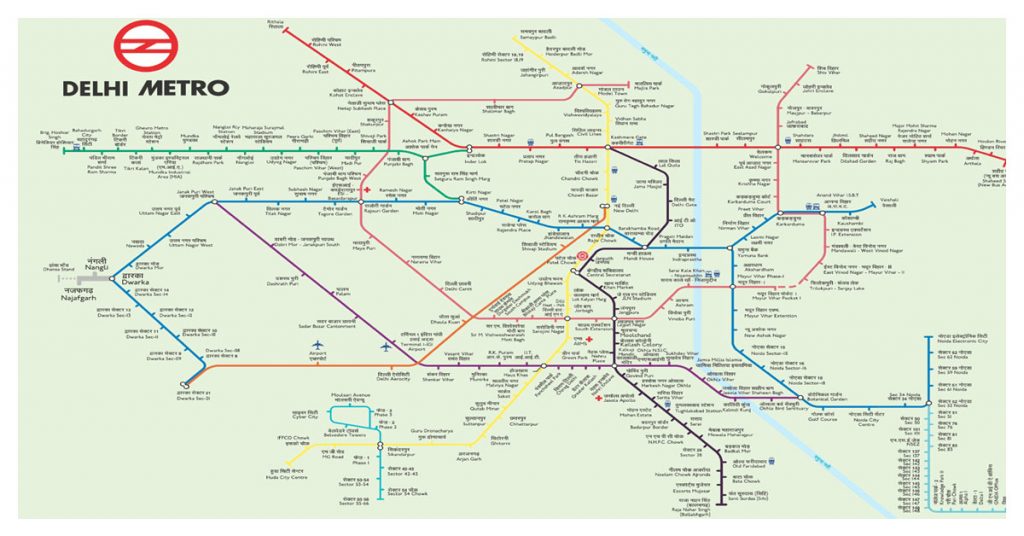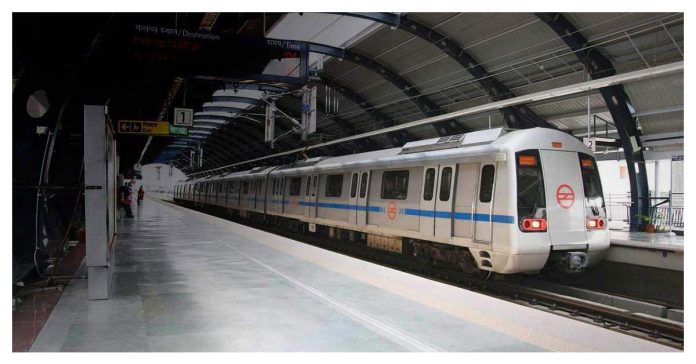The Delhi Metro is a public transportation system that serves Delhi and the National Capital Region. The system has over 350 kilometers of rails on the land, above ground, and underground. Its 254 stations receive about 47 lakh visitors per day. The Delhi Metro was built in three phases, the first two were radial lines, and the third was a semicircular and circular route. The trains run at speeds of up to 80 km/h, pausing for 20 seconds at each station. The trains, which have four, six, or eight carriages, run every 1–4 minutes during peak hours and every 5–10 minutes during non-peak hours. Standard-gauge (1435 mm) tracks are used on certain lines, whereas broad-gauge (1676 mm) rails are used on others.
Quick information on the Delhi Metro Map
- Delhi Metro Rail Corporation is the owner (join-venture between Government of India and Government of NCT of Delhi)
- Delhi, Bahadurgarh, Gurgaon, Faridabad, Ghaziabad, and Noida are among the cities served.
- The number of lines is ten.
- Metro Bhavan, Barakhamba Road, is the organization’s headquarters.
- In 2002, the company began operations.
- Timetable: 5:30 a.m. to 11:30 p.m. (varies with station)
- Ticket prices range from ₹10 to ₹60.
Route of the Delhi Metro

The Delhi Metro is a rapidly developing local rail system. There are presently nine lines in use. The metro is being built in stages, with phase IV anticipated to be finished by 2024.
What you should know
- In December 2002, the Red Line became operational for the first time. From Dilshad Garden to Rithala, it connects northeast and northwest Delhi. The whole route is elevated and spans 24 kilometres, with 21 stops. At Kashmere Gate, it connects to the Yellow Line, and at Inderlok, it connects to the Green Line.
- The Yellow Line began service in December of 2004. It runs 49 kilometres from north to south Delhi and links to the Gurgaon Rapid Metro. The majority of it is located underground. With 37 stops, this is the second-longest line on the Delhi Metro. It connects to the Red, Blue, and Violet lines and the train stations of Old Delhi and New Delhi. At New Delhi station, the route also connects to the Airport Express Line. The helpful Yellow Line covers several of the city’s main sites if you’re interested in sightseeing.
- The Blue Line is the Delhi Metro’s longest line, having opened in December 2005. It has 44 stops and runs for 50.5 kilometres from Dwarka Sector 21 to Noida City Center (Sector 32). It interchanges with the Green, Yellow, and Violet lines and links to the Airport Express Line. It also has an eight-station branch line that runs from Vaishali to Yamuna Bank.
- The Green Line is the quickest Metro line, yet it is vital for commuters commuting from west Delhi to the Red and Blue lines. Mundka, Nangloi, Paschim Vihar, and Punjabi Bagh are covered in the major business and residential areas. In April 2010, the first section of the line was made operational.
- The Violet Line began operations in October of 2010. It’s a convenient route that links downtown Delhi to south Delhi’s interior and the satellite town of Faridabad. The 35-kilometre route connects to the Blue Line at Mandi House and the Yellow Line at the Central Secretariat. The Heritage Line, a continuation of the Violet Line, debuted in May 2017. It connects the Red and Yellow lines at Kashmere Gate and offers direct access to Jama Masjid, Delhi Gate, and the Red Fort in Old Delhi.
- In February 2011, the Airport Express Line (Orange Line) debuted. It links the New Delhi Railway Station with the Delhi International Airport. It comes to an end in Sector 21 in Dwarka, where it meets the Blue Line.
- A station at New Delhi Airport Domestic Terminal 1 is included on the Magenta Line from Janakpuri West to Botanical Garden. At Hauz Khas, the Yellow Line, the Blue Line at Janakpuri West and Botanical Garden, and the Violet Line at Kalkaji Mandir also have interchanges.
- The Pink Line is also known as the Inner Ring Road because it travels alongside Delhi’s bustling Ring Road. It began service in March 2018 and runs between Majlis Park and Shiv Vihar. It is the longest Metro line in the world.
- The Gray Line, which connects Najafgarh and Dwarka, debuted in October 2019.
- At Sikandarpur, the completely elevated Rapid Metro Line connects Gurgaon to the Delhi Metro’s Yellow Line. The project’s first phase began in November 2013. From 6.05 a.m. to 10 p.m., trains operate every four minutes. Tickets start at 20 rupees and are connected with the Delhi Metro’s ticketing system.
Facts about the Delhi Metro that aren’t well known
- Station escalators feature a saree guard to keep sarees from becoming trapped.
- Phase 1 was finished three years ahead of schedule.
- The Pink and Orange Lines intersection at Dhaula Kuan is the system’s highest point, at 23.6 kilometres above sea level.
- The deepest station is Hauz Khas (Pink Line), which is 29 meters below the earth.
- The Metro Man, E Sreedharan, was the first Managing Director of the Delhi Metro.
- The United Nations has granted the first carbon credits to a metro system for lowering greenhouse gas emissions (6,30,000 tonnes every year)
- DMRC does rainwater harvesting all along the Blue Line.
- The busiest and largest metro in India, as well as the one with the most stops.
New information on Delhi metro
The Grey Line adds a new stop as the metro reaches out to Delhi’s rural heartland. The recently built Dhansa Bus Stand station is an underground facility that extends the Grey Line route from Dwarka to Najafgarh. Dwarka, Nangli, Najafgarh, and Dhansa Bus Stop will now be the four stations on the line.
Rapid transit systems across India
Under construction (as of September 2021)
- Meerut Metro
- Surat Metro
- Agra Metro
- Patna Metro
- Indore Metro
- Bhoj Metro
- Kanpur Metro
- Navi Mumbai Metro
- Pune Metro
Approved (as of September 2021)
Guwahati Metro
Proposed (as of September 2021)
Coimbatore Metro


